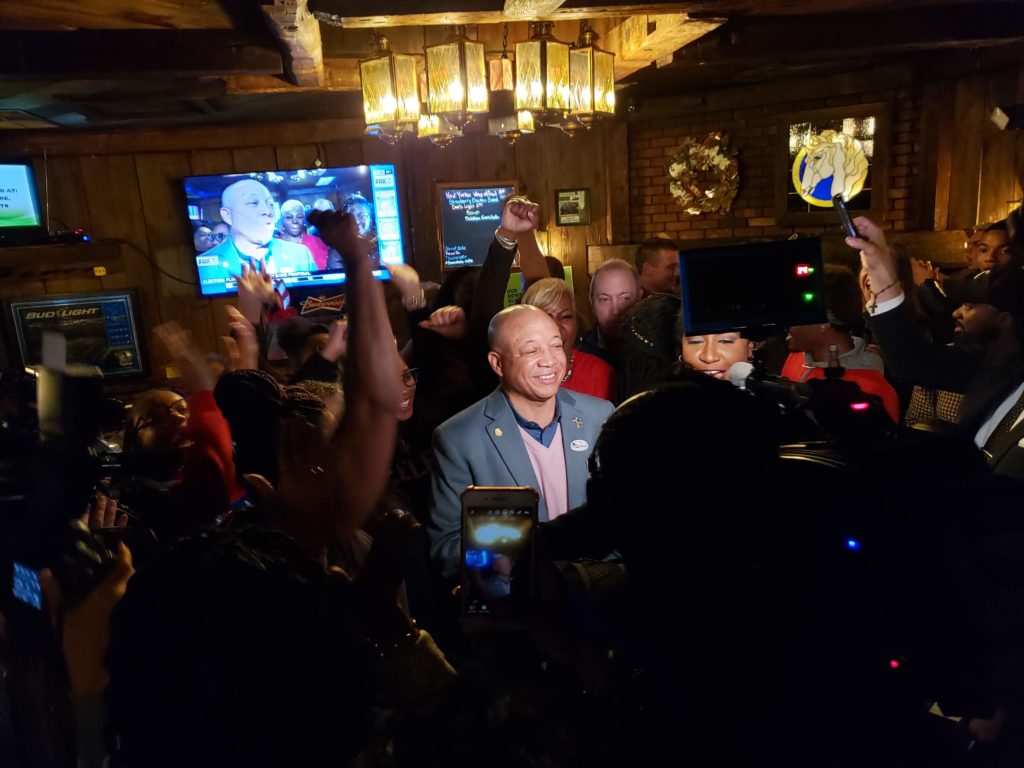
As the election results came in local news media and family and supporters of Sheldon Neeley gathered at the White Horse Tavern. Against the back drop of the large screen TV revealing the nail-biting results of a Neeley victory, the crowd started to chant, “Neeley, Neeley, Neeley!!” The mayor-elect conducted interviews with each of the local TV reporters amidst the shouts and cheering. It was a jubilant time with tears of joy flowing, high-fives, emotional hugs, and the energy of victory (Photo by Tom Travis)
By Paul Rozycki
This year nearly everyone expected a close race to elect the Flint mayor, and that’s what they got. After a hard fought campaign, State Rep. Sheldon Neeley emerged as the victor with just over 50 percent of the vote, edging out incumbent mayor Karen Weaver by 205 votes, 7082 to 6877.
At her election night gathering, Weaver said she has not conceded, and “hasn’t ruled out a recount.”
Countywide, including all elections, it was a turnout of 13 percent, 23,349 of 176,795 registered voters, with all 70 precincts reported in. That was up slightly from the 12 percent August primary. Just under 14,000 Flint residents voted.
Library funding robustly approved
Though the mayor’s race was the major one in Flint, it wasn’t the only issue on the ballot. By better than a 2-1 margin Flint voters approved both a renewal of the current Flint Public Library millage, and a new millage for a $12.6 million bond issue to redo the library. An additional $15 million has been raised from private donors for the $27.6 million renovation and expansion of the 60-year-old structure.
Before the election some were concerned that by putting both issues on the ballot only the renewal might pass. Both proposals earned more than a 70 percent support from the public. Prior to the election library officials held several open house meetings where they explained the plans for the new library.
Domino effect in state representation
Neeley’s election means that there will be a vacancy in the 34th district seat and the governor can call for a special election to fill his seat in the state legislature. At this time only Santino Guerra, a 3rd ward member of the city council, has filed to run for the seat, though others are expected to throw their hats in the ring.
Neeley’s campaign
Neeley highlighted his experience as a member of the Flint City Council nine years, and as a state representative for the 34th district for three terms. He had been a union leader while he worked at WJRT-ABC 12 in Flint. While in Lansing, he was elected chair of the Black Caucus in the state House. This is his second run for mayor. He ran unsuccessfully against Dayne Walling in 2009.
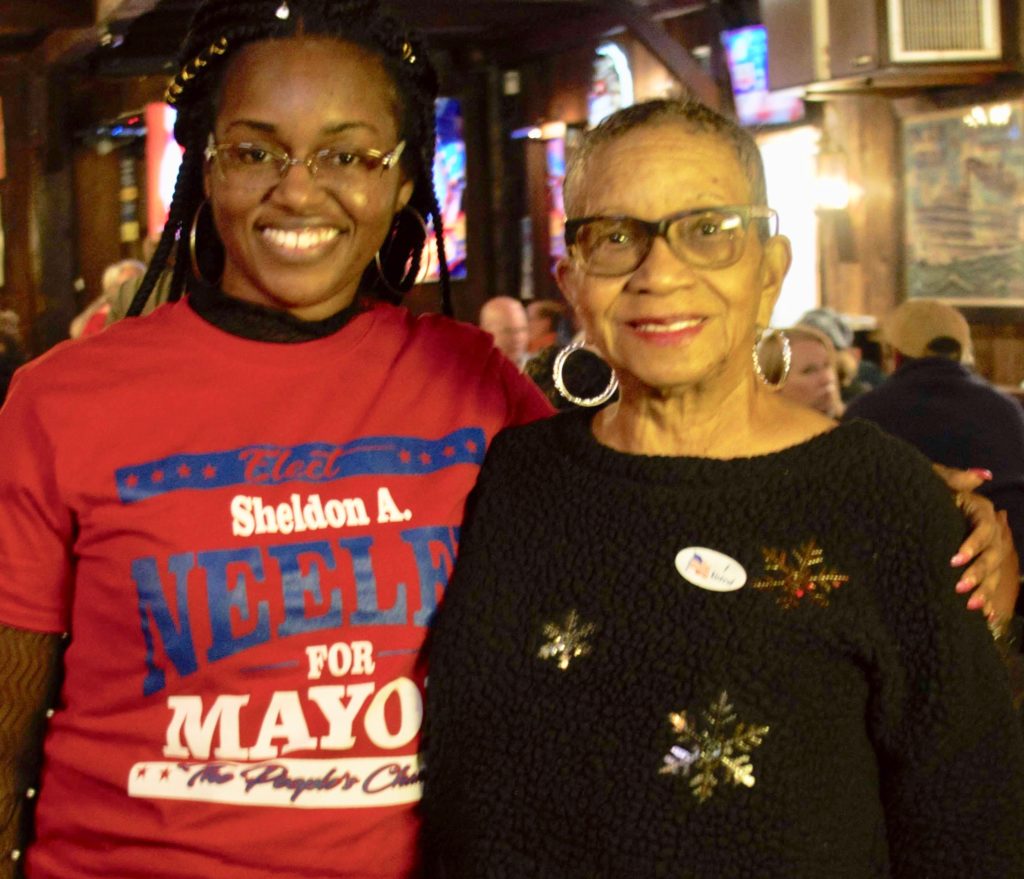
Mayor-elect Sheldon Neeley’s mother, Marva Neeley (right) and his niece Marquay Neeley celebrating at the election night party (Photo by Tom Travis)
The campaigns revolved around a number of issues. His campaign focused on the rising crime rate in Flint, the water crisis, and what he called accountability in city hall. One of his first actions as mayor, he said, would be doing a financial audit of the city, particularly of the water crisis funds.
Neeley earned the endorsement of four members of the Flint City Council, four members of the Flint School Board and several labor unions. He also relied on his long history of community involvement for his campaign.
Over the years, Neeley has held a number of community events—most recently a series of meetings where those with criminal records could, in some cases, have their records cleared. After his victory Neeley said “I’m looking forward to bringing the city back together.”
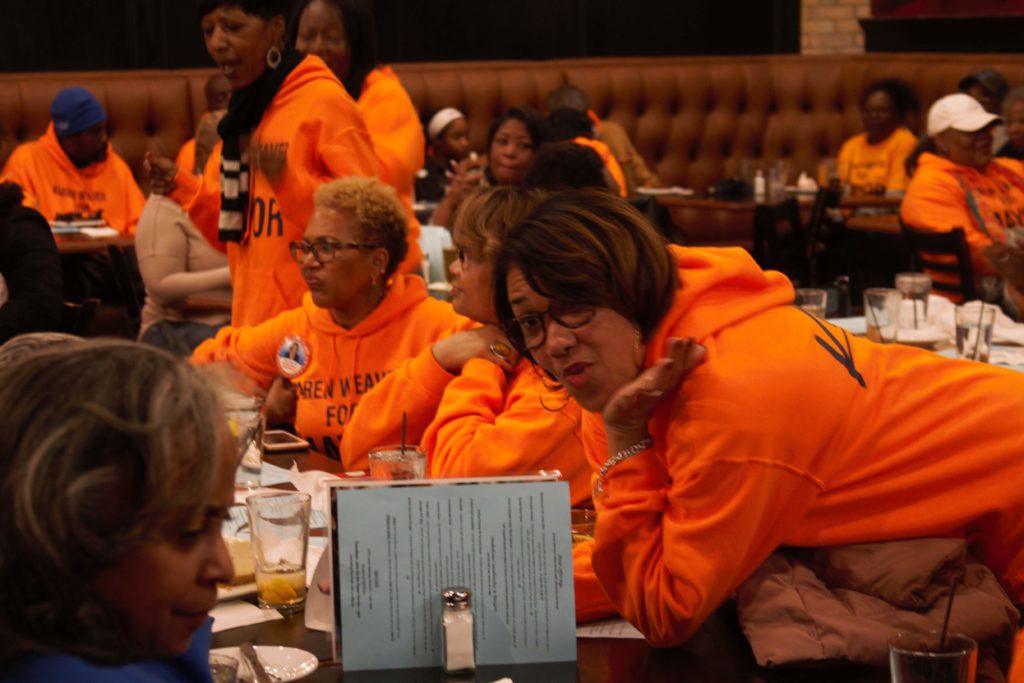
Weaver chats with a table of relatives at a somber election night party at Blackstone’s (Photo by Tom Travis)
Weaver’s campaign
Weaver’s campaign emphasized a number of accomplishments during her term—the end of the emergency manager in Flint, the replacement of nearly all of the lead pipes by the end of the year and the national attention she brought to Flint and the water crisis with visits from celebrities and national figures. She also highlighted economic development in the downtown and new jobs that have come to the area.
Though this was her first political office, Weaver surprised many with her victory over Mayor Dayne Walling in 2015, and her strong victory when she faced a recall attempt in 2017. Her key issue has been dealing with the water crisis. She campaigned on “finishing the job” of solving the water crisis.
According to campaign finance reports her campaign raised substantially more money than Neeley’s, nearly $300,000 compared to Neeley’s $55,000. She earned the endorsements of a long list of area pastors, the Flint Police Officers Association, other law enforcement officials, local business leaders and four members of the Flint City Council.
On election night Neeley supporters celebrated with supporters at the White Horse Tavern, and Weaver backers gathered at Blackstone’s Smokehouse in downtown Flint.
Unusual election
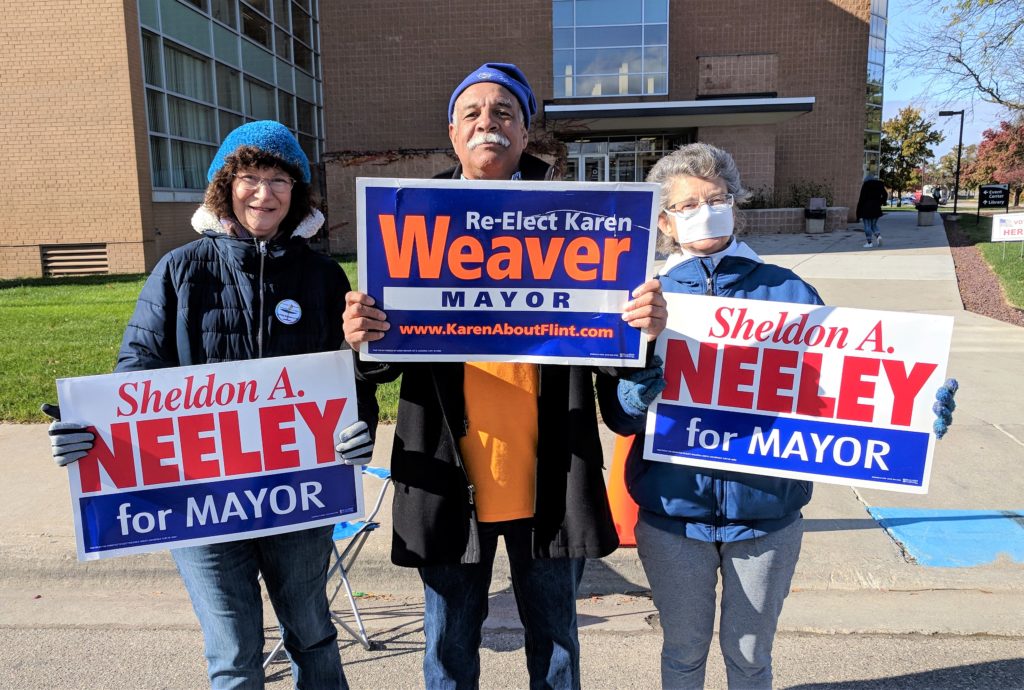
From left, Terri Cross, Jack Pitts and Chris Monk at MCC working the polls for their candidates Tuesday (Photo by Paul Rozycki)
This election was unusual in a number of ways. It is the first general election under the new city charter, which was approved almost two years ago. When four candidates initially filed for the August primary there was a possibility that several, or all of them, could have been forced off the ballot because of flaws in their petitions. After a series of legal challenges all remained on the ballot. The close results in the general election were reflected in the August primary where Weaver got 42 percent and Neeley got 39 percent of the votes.
Mayor Neeley will serve a three-year term—until 2022. After that, mayors will serve four-year terms, and be elected at the same time as the governor. It was also the first Flint mayoral election where two African-Americans faced each other. Over the last 40 years typically Flint has nominated a white candidate and a black candidate, and the votes have often divided along racial lines.
Low turnout
One factor the in the race was the relatively low turnout for the general election. About 13 percent of eligible voters turned out, just slightly more than the 12 percent who voted in the August primary.
Many observers expected a turnout closer to the 20 percent average that Flint sees for a general off year election. The low turnout was surprising even though the Weaver campaign sponsored a number of ‘get out the vote’ efforts as they brought Jesse Jackson Jr., Martin Luther King III, and others, to town to encourage voters to turn out.
One factor in both the outcome of the election and the low turnout may be that there is still a great deal of distrust in the system and local officials. Even with some real accomplishments, the distrust over “city hall” may have hurt the Weaver campaign and lowered turnout.
Looking ahead
As Sheldon Neeley takes over the mayor’s desk, he will face the same challenges that all recent mayors have had to deal with—the water crisis, rising crime rates, limited financial resources, and perhaps most important, the lack of trust in city hall. Much of Neeley’s campaign was based on restoring trust in local government.
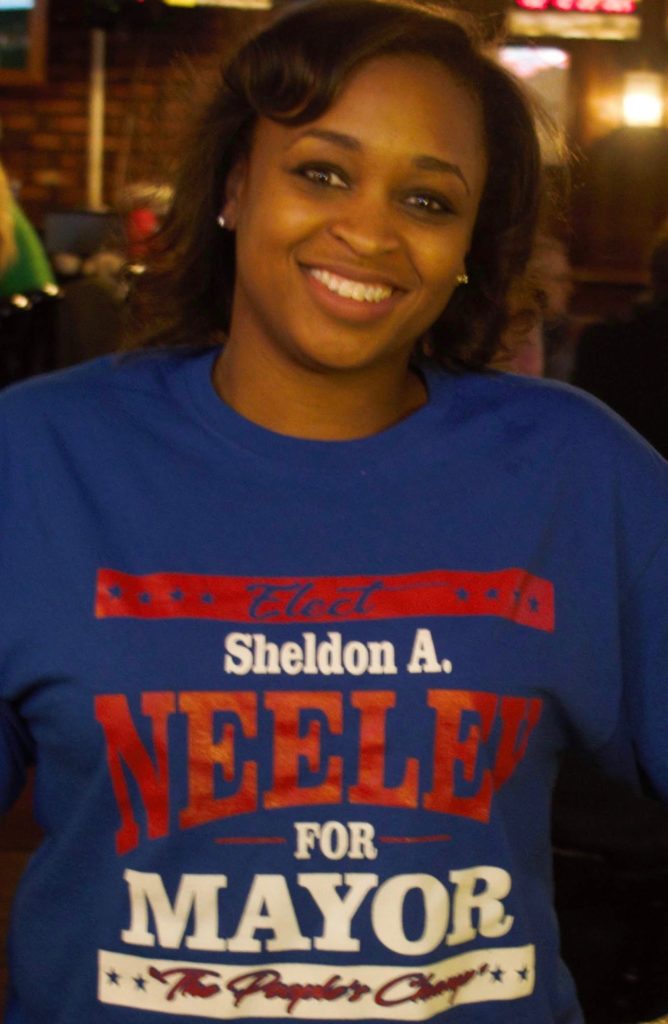
Kesha Barrett (Photo by Tom Travis)
Kesha Barrett, a volunteer with the Neeley campaign spoke with East Village Magazine at the White Horse. Barrett said she has known Neeley since she was 14 years old and reflected on the campaign as the results poured in.
“The biggest struggle with this campaign has been the divisiveness. All the back biting, the lies, the inconsistencies and mistruths,” she said.
“The most effective way of getting our message across in this campaign has been through social media. Sheldon isn’t very comfortable with that format but he trusts his team to help do this. Sheldon is much more going up to people and shaking their hand and looking at them in the face.”
Barrett said there was a core team of about 10 on the campaign and “tons of volunteers.”
“We’ve gotten the message out and gotten it across. The people are tired of the same old thing and there are a lot of issues in city hall. There’s not a lot of representation in city hall and people are tired of that,” she said.
Burton mayoral election
And while there were a number of other issues around the county, Flint wasn’t the only close race in the area. In Burton, the race was to replace Mayor Paula Zelenko, who chose not to run again. In that mayoral contest, Duane Haskins topped Danny Wells with a margin of 70 votes, 2115 to 2045.
Banner photo of polling place signs Nov. 5 by Paul Rozycki.
EVM Staff Writer and political commentator Paul Rozycki can be reached at paul.rozycki@mcc.edu. EVM Staff Writer Tom Travis contributed to this report and can be reached at tomntravis@gmail.com.


You must be logged in to post a comment.